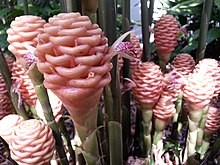Zingiber spectabile
| Zingiber spectabile | |
|---|---|

| |
| Scientific classification | |
| Kingdom: | |
| (unranked): | |
| (unranked): | |
| (unranked): | |
| Order: | |
| Family: | |
| Genus: | |
| Species: | Z. spectabile
|
| Binomial name | |
| Zingiber spectabile | |
Zingiber spectabile is a species of true ginger, native to Maritime Southeast Asia. It is primarily grown in the West as an ornamental plant,[1] although it has been used in South-East Asia as a medicinal herb.[2]
Name
The scientific name of the species, Zingiber spectabile, comes from two words. "Zingiber" is originally from a Sanskrit word that means "shaped like a horn" and refers to the horn-shaped leaves of most species of ginger. "Spectabile" is derived from the Latin spectabilis, meaning 'visible' or 'spectacular'.[3]
The plant is commonly known in the West by the common name "beehive ginger", due to its unusual inflorescences which resemble a skep beehive.[3] It is also referred to by the common names "Ginger wort" or "Malaysian ginger".[4]
Description
In common with most plants in genus Zingiber, the leaves of the plant are long and mostly oblong shaped, tapering to a single point at their tip. Under ideal circumstances, the plant can reach a height of 4.5 metres (15 ft), or even more.[5]
The plant's inflorescence is set atop a spike and can measure up to 30 centimetres (12 in) in height. The bracts attached to the structure can differ in colour, from white, to yellow, orange, or even red, often darkening as the bracts mature and develop.[3] The flowers themselves are small, with purple petals and yellow spots, and a fragile, papery texture.[5]
Uses
In Malaysia, the plant has been used in traditional medicine[6] to treat inflammation of the eyes.[2] It is prepared for use by pounding the leaves of the plant into a thick paste, and then topically applying it to the required part of the body. It has also been recorded being used to treat burns, as a treatment for headaches and back pain, and as an agent for food preservation.[5]
Academic research has found that the plant has antimicrobial properties,[7] and significant concentrations of the Zerumbone synthase enzyme, which may be effective in treating colon cancer.[8]
References
- ^ Forsyth, Holly (2007). The Constant Gardener. Miegunyah Press. p. 100. ISBN 9780522854329.
- ^ a b Wiart, Christophe (2012). Medicinal Plants of China, Korea, and Japan. CRC Press. pp. 70–71. ISBN 9781439899113.
- ^ a b c Simpson, Donald. "Zingiber spectabile Griff". Retrieved 2 November 2013.
- ^ "Zingiber spectabile (Beehive ginger)". Herbcyclopedia. Retrieved 2 November 2013.
- ^ a b c Chee, Beng Jin. "The Spectacular Ginger: Zingiber spectabile". September 2010. Malaysian Naturalist: 12–13.
{{cite journal}}: Cite journal requires|journal=(help) - ^ Weiss, E. A. (2002). Spice Crops. CABI. p. 338. ISBN 9780851996059.
- ^ Dubey, N. K. (2011). Natural Products in Plant Pest Management. CABI. p. 69.
- ^ Sadhu, Samir Kumar (2007). "First isolation of sesquiterpenes and flavonoids from Zingiber spectabile and identification of zerumbone as the major cell growth inhibitory component". Natural Product Research. 21 (14): 1242–1247. doi:10.1080/14786410701371421. ISSN 1478-6419.
{{cite journal}}: Unknown parameter|coauthors=ignored (|author=suggested) (help)
